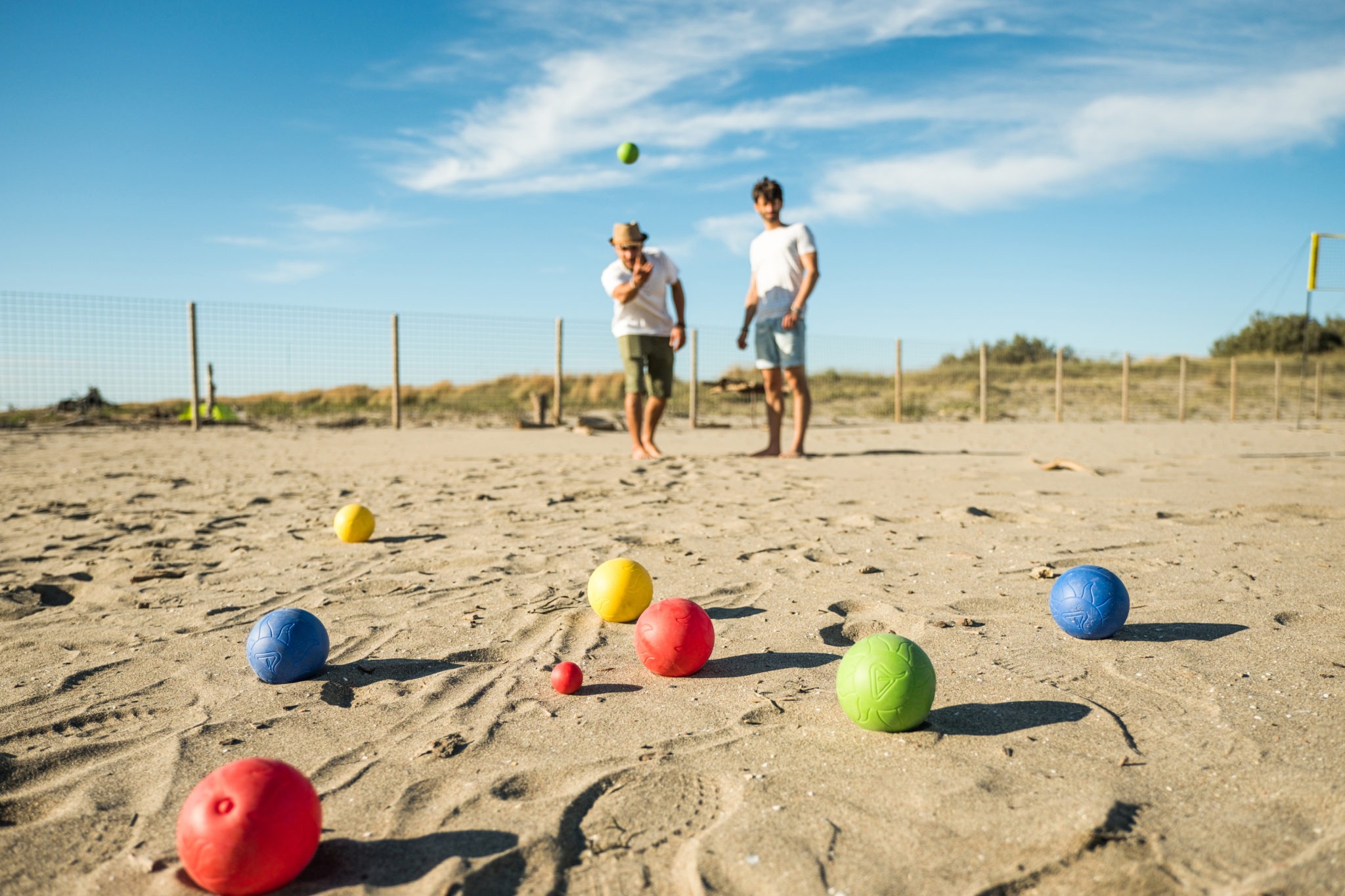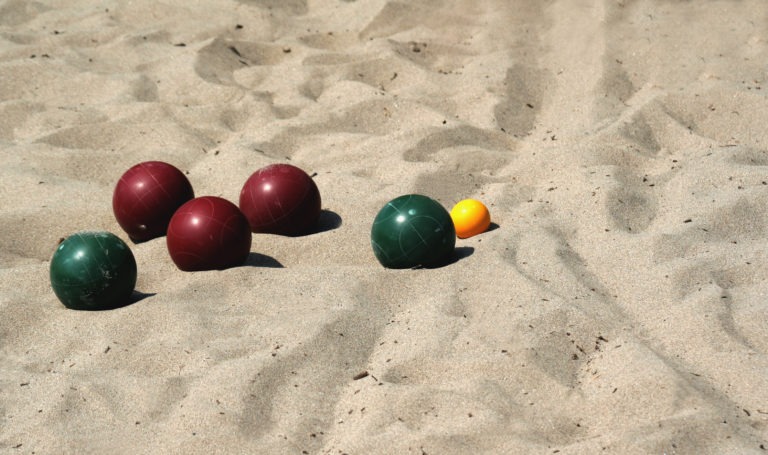People of all ages can be seen playing bocce ball throughout Europe, whether it be in parks in crowded cities, on well-liked beaches, or even on cobblestone streets in charming neighborhoods. It is a game that is occasionally played on cruise ships or in Italian bistros in the United States. But this impression might soon shift.
Soccer may be the most popular ball game in the world, but bocce (bah-chee) ball is one of the oldest games involving round objects. It can be played as a one-on-one match or between teams of up to four players. Almost any flat surface can be used to play bocce ball. Bocce ball is in many ways the ideal game for today’s technologically advanced society. Everything you need can fit inside a gym bag, making it portable. It only requires a few people to play, and it can be organized with a few phone calls (or text messages).
To learn the bocce ball rules and how to play the game, keep reading this article.
A Brief Background
In its most basic form, bocce ball can be described as a game that rewards both physical skill and mental strategy. The Italian word boccia, which means “ball,” is the singular form of the word bocce. The game we play today is most closely associated with Italy, and it has an undeniably long and rich history, having been a favorite pastime of famous historical figures like Galileo Galilei and Leonardo da Vinci.
The Roman Empire of antiquity is to thank for the popularity of bocce ball. Roman soldiers reportedly passed the time in 264 B.C. by throwing bigger rocks toward a smaller, previously cast “leader” stone to see which would land closest. It is hypothesized that playing this game kept soldiers’ minds active, which helped them perform better on the battlefield. Some historians assert that bocce ball originated in Greece around 600 B.C., while others think that the ancient Egyptians were playing a game very similar to bocce ball as early as 5,200 B.C. Regardless of when bocce ball in its current form was actually created, it is undeniable that it is one of the oldest ball games.
Italian immigrants who brought their cherished sport from Italy to the United States are responsible for bocce ball’s introduction. There are numerous bocce ball clubs and associations from coast to coast, and there are organizations that take the sport very seriously, adhering to official European rules regarding the court, the balls, and the way the game is played. Some competitions even have bocce ball referees.
The Object of Bocce
In each round of bocce ball, one player or team competes against the other to score a certain number of points first. Before delving deeper into gameplay and the game’s specific rules, let’s start with a few fundamentals. The United States Bocce Federation (USBF) has established the regulations for games played under open rules. Although these regulations follow the same spirit of play as their European counterparts, such as the Confederazione Boccistica Internazionale and the Federation International de Boules, they are much more lax in how they handle issues like the playing surface, court size, and gameplay mechanics.
Equipment in Bocce Ball
1. Bocce ball kit
These are available at surf shops. Eight large balls, in two sets of four, are included. To distinguish the various teams, each set is a different color. The pallino, also known as the jack, is a tiny white ball.
2. A sizable play area
The beach is a great place to play since there is a lot of open space and most courts are about 27 feet long and 13 feet wide. All you need to do is mark out a space for your “court” in the sand.
How is Bocce Ball played?
The rules governing the equipment, the court, and the gameplay of bocce ball are fairly simple, and they can be quickly learned. Playing the game, preferably with guidance from someone who has played it before, is for many people the simplest and fastest way to pick it up.
1. The Game’s Start
With two players on each team, bocce is played. Two substantial bocce balls are used by each player. The objective is the pallino, a smaller ball. While bocce is a game that is officially played on a court, players typically play it wherever they can find a flat surface that is large enough for the balls to roll on. It is up to the teams to decide which side will go first. Players should toss a coin to decide who goes first.
2. Gameplay
The area where the pallino comes to rest becomes the target after being thrown by the team that goes first. Then, as everyone prepares to throw, they should all stand behind a line. On where it is fair to stand, most people can agree. The group who threw the pallino is the one who launches the first bocce. The throwing of the eight balls is done in a round-robin fashion between teams and players. To make their team’s bocce as close to the pallino as possible, players compete. In many friendly games, however, players simply switch from one team to the next. It is, however, recommended that players alternate by allowing the team that is farthest from the pallino to throw.
3. Scoring
There is only one winning team, determined by which team’s bocce is closest to the pallino. The closest team, also known as the inside team, is awarded points in proportion to how many of their bocce are closer to the pallino than the nearest bocce of the opposing team. A bocce is deemed a baci and the team receives 2 points for that ball if it touches the pallino during play. A round of bocce lasts until a team scores a certain number of points, and one round is equal to one game. 9, 11, 12, and 15 are typical point totals. Using a stick or tape measure to measure the distance from the pallino can help resolve any disputes. No points are given to either team if the score is tied or there is a disagreement that cannot be resolved.
4. Violations
A player commits a foot fault when they cross a marked line while throwing the ball. A warning or the invalidation of that throw may result from the penalty. Being warned will help most players adhere to the rules because bocce is a social game. Teams can decide to replace the balls roughly where they were before if a player throws out of order, or they can decide to let it go. The opposing team should not attempt to divert a thrower in any way.
The Bocce Ball Teams
In bocce ball, there are always two competing teams, no matter how many players are involved. Typically, teams have one, two, or four players each. Local bocce ball clubs and leagues regularly impose altered rules to speed up play or address potential safety issues. The ability to play games between three-player teams has recently undergone modification. In this scenario, each player on each team throws two balls, for a total of six balls per team, making a total of 12 bocce balls plus the pallino available for play.
Court Specifications
Despite the fact that bocce ball can be played almost anywhere, there are specific court dimensions when taking part in regulated or officiated activities, such as tournament play. A rectangular bocce ball court is required by law to be 86.92 feet long (26.5 meters) and 13.12 feet wide (4 meters). A 76-foot court is typically used in place of a full-size court because of space restrictions in many instances.-
In addition to several important line markings inside the bocce ball court, the court should have a defined perimeter to mark its outermost boundaries. The players are given 13 feet to run up to the foul lines, which are marked 13 feet from the end of the court and drawn parallel to the center line. The foul lines will be drawn six feet in from the ends of the court toward the center line (on a 76-foot-long court). When releasing their throw, players are permitted by the rules to step on the foul line. So, even if a player releases the ball while their heel is on the foul line, it is still a legal throw. However, if a player’s foot completely crosses the foul line and he releases the ball while facing the bocce ball court, the ball is disqualified and must be taken off the court.
Additional Bocce Court Features
Wooden planks (or concrete curbs) that protrude a few inches from the ground will serve as the outer perimeter markers for permanent bocce ball courts. Whether on purpose or as a result of an unintended throw, these raised boundary walls allow bocce balls and even the pallino to bounce or bank off them. The back of each end of a standard bocce ball court will be covered with a plank made of wood or rubber. These are called “backboards,” and they are intended to stop balls from flying off the court due to excessively forceful throws or collisions between balls.
What are the playing surfaces of the Bocce Ball?
Contrary to international (European) standards, American bocce ball regulations allow for more forgiving playing surfaces. Unlike recreational courts, which typically have dirt, carpet, turf, or even concrete surfaces, tournament-level bocce ball matches are played on surfaces made of crushed stone (in some cases mixed with oyster shells) or clay.
Guidelines in Playing Bocce Ball
A coin flip typically decides which team kicks off play after the two opposing teams have been assembled and the bocce balls assigned. Rounds are the fundamental unit of play in bocce ball games, but only one team receives points for each round. Each game will have as many of these “frames,” or rounds, as are required for one team to accumulate the specified number of points to win the match. The honor team throws out the pallino to establish the target for that frame, and then play begins. Pallino must cross the center line and be farther than 12 inches from the court’s back end. The first Pallino throw is forfeited, and the opposing team is given the chance to start the game if the thrower doesn’t place it in an appropriate location.
Conclusion
Bocce ball is among the best games you can play, especially at the beach. You don’t have to worry about getting sweaty because it’s a simple, relaxed game that anyone in your family can play. To make your next game more enjoyable and memorable, make sure to read the tips and basics in this article.


